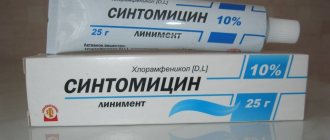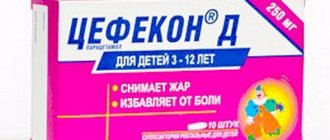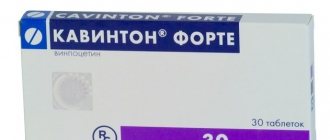Flucinar has a pronounced anti-inflammatory effect due to the inhibition of leukotrienes and prostaglandins. Flucinar® ointment and gel is a topical hormonal agent. The product has a synthetic composition and has antiallergic and anti-inflammatory properties. The ointment is prescribed for inflammatory diseases of the skin, which are accompanied by severe itching and burning. It is actively used in dermatology.
General description and composition
Flucinar ointment is a hormonal drug for topical use, which contains corticosteroids. The main active ingredient is fluocinolone acetonide. It has pronounced vasoconstrictor, anti-inflammatory and antiallergic effects.
Compound
Flucinar® ointment for external use
white or almost white, translucent, oily.
| Main active ingredient: | In 1 year |
| fluocinolone acetonide | 250 mcg. |
Excipients in the ointment
: propylene glycol – 50 mg, citric acid – 0.01 mg, anhydrous lanolin – 40 mg, white petrolatum – up to 1 g.
15 g each - aluminum tubes (1 piece) - cardboard packs.
Flucinar® N ointment for external use
in the form of a light yellow, translucent in a thin layer, fatty soft mass.
| Main active ingredient: | In 1 year |
| fluocinolone acetonide | 0.25 mg. |
| neomycin sulfate | 5 mg*. |
| which corresponds to the content of neomycin | 3400 IU. |
* neomycin sulfate – 650 IU/mg.
Excipients in Flucinar® N ointment
: propylene glycol, liquid paraffin, lanolin, petroleum jelly – up to 1 g.
15 g each - aluminum tubes (1 piece) - lithographed cardboard packs.
Gel Flucinar® for external use
in the form of a colorless, transparent jelly-like mass with a faint odor of ethanol.
| Main active ingredient: | In 1 year |
| fluocinolone acetonide | 0.25 mg. |
Excipients in the gel
: propylene glycol, ethanol, disodium edetate, citric acid, methyl parahydroxybenzoate, propyl parahydroxybenzoate, carbomer 980, trolamine, purified water.
15 g each - aluminum tubes (1 piece) - lithographed cardboard packs.
Clinical and pharmacological group of medicine : GCS for external use.
Pharmacotherapeutic group of the drug : Glucocorticosteroid for local use.
The auxiliary components of the ointment are petroleum jelly, citric acid, lanolin and propylene glycol.
The active substances of Flucinar ointment penetrate into the deep layers of the skin and remain for a long time in the stratum corneum.
The drug is characterized by a wide range of applications: it can be used to treat both the skin of the body and the scalp.
After applying the ointment to the skin, its active substances penetrate into the deep layers of the skin. They remain in the stratum corneum for quite a long time. The components are absorbed into the systemic circulation, but in minimal quantities.
Patients are often interested in whether Flucinar ointment is hormonal or not. Since this drug is included in the glucocorticosteroid component, it is truly hormonal. Fluocinolone acetonide is a potent hormone, so the product is used only as prescribed by a doctor.
The drug is dispensed from pharmacies without a prescription.
Special conditions
Before using Flucinar gel or ointment, you should carefully read the instructions and pay attention to several precautions, which include:
- When starting treatment with this drug, lichen planus may experience an exacerbation of symptoms.
- The drug does not have a direct effect on the functional activity of the structures of the nervous system.
- It is not recommended to use the drug on large areas of the skin and for a long time to prevent the development of complications or negative side reactions.
- The appearance of severe irritation after applying the drug to the skin is grounds for stopping its use.
- If severe dryness develops on the skin after starting to use the drug, it is additionally allowed to apply 5% salicylic ointment.
- The use of the drug during pregnancy, as well as in young girls during puberty, is not recommended, since absorption of the main active component into the systemic bloodstream cannot be ruled out.
Indications for use
Indications for use of the topical agent Flucinar:
- contact and impetiginous eczema;
- skin burns of the first degree of severity including sunburn;
- insect bites;
- dermatitis of various types (atopic, allergic, seborrheic);
- lichen planus;
- psoriasis (including scalp disease);
- lupus erythematosus;
- hives;
- erythema;
- itchy skin caused by infection or allergic reaction.
Note! Regardless of what disease the patient has, the ointment is used exclusively for a short course.
Flucyanar for infants and during pregnancy
There have been no controlled studies of teratogenicity (the ability of a chemical composition to cause structural and functional defects during fetal development) with topical application of Flucinar. The composition is not safe for the fetus in the 1st trimester of pregnancy; short-term use of the product as prescribed by a doctor is allowed for 4-9 months.
During lactation, Flucinar is also prescribed in exceptional cases, for a short time and on limited areas of the skin. Application of the drug to the mammary glands is prohibited. Glucocorticosteroids pass into breast milk in small doses, avoiding problems with the development of the newborn. The medication is contraindicated for children under 2 years of age.
READ ALSO: Indications for using an alcohol compress and how to do it correctly
Instructions for use
Flucinar® ointment
The use of the ointment should be carried out strictly according to the instructions. Flucinar® ointment should be used externally up to 3 times a day. The maximum number of applications is necessary in the first days of treatment. As the severity of the inflammatory process decreases, the amount of application should be reduced to 1-2 times a day.
If the ointment is used to treat facial skin diseases, the course of treatment should not last longer than 7 days. If the drug is required for application to other parts of the body, then the duration of treatment will be 2 weeks.
Flucinar ointment must be used strictly according to the instructions; for the treatment of facial skin diseases, the course should not exceed seven days, for other parts of the body - up to two weeks.
Do not apply a bandage over the area treated with ointment (except in cases of psoriasis).
When applying the drug, you need to rub it in very carefully, with light movements.
When applying Flucinar, you should not apply this topical agent to healthy areas of the skin.
Flucinar® N ointment
In adults
the drug should be used no more than 1-2 times a day. The course of continuous therapy with ointment is no more than 2 weeks, on the skin of the face - no more than 7 days. During the week, you can use no more than 1 tube of ointment (15 g).
The ointment should not be used under an occlusive dressing.
Flucinar® N is contraindicated in children under 2 years of age.
.
In children over 2 years old
Flucinar® N should be used with great caution, only 1 time/day on small areas of skin under the supervision of a physician, in short courses; should not be used on the face.
Gel Flucinar®
Adult patients
at the beginning of therapy for acute conditions, the gel is prescribed 2 to 3 times a day, then therapy is continued, using the gel no more than 1-2 times a day.
In children over 2 years old
Flucinar® gel should be used with great caution, in minimal effective doses, only 1 time/day, on small areas of the skin, under the supervision of a physician, in short courses (no more than 5 days); should not be used on the face.
Flucinar® gel is contraindicated in children under 2 years of age
.
Flucinar ointment
Medicinal, hormonal agent. Application: treatment of acute dermatitis.
Approximate price (at the time of publication of the article):
- Ointment - 225-243 rubles.
- Gel – 236-241 rubles.
Today we will talk about Flucinar ointment.
What is the difference between ointment and gel? In what cases will this remedy help cure an obsessive skin disease, and in what cases is it better not to use this ointment and gel?
Flucinar ointment is a hormonal preparation made from glucocorticosteroids.
Flucinar is a potent hormonal drug. It is used for severe skin diseases that occur with a general deterioration in health. The drug is able to stop the inflammatory process, relieve itching and non-infectious skin lesions.
Glucocorticosteroids are hormones that are produced by the adrenal glands during times of stress. They participate in the restoration of the body after injuries and help during blood loss. Strongly influence the self-regulation of the immune system. By spurring the body to self-healing, hormones of this group help get rid of diseases and act as anti-inflammatory agents.
Apply the product externally.
The drug is produced in the form of ointment and gel.
Active substance
The main active ingredient of the drug is fluocinolone acetonide. This is an anti-inflammatory drug.
Application of Flucinar ointment and gel
Flucinar ointment is prescribed for psoriasis in the acute period, when in order to normalize the patient’s general condition it is necessary to relieve itching and inflammation.
After the first use, the ointment eliminates the symptoms of the disease and alleviates the patient’s situation.
Indications for prescribing the drug in the form of an ointment may include diseases such as:
The ointment effectively relieves itching and allergic manifestations from wasp, bee, mosquito bites and urticaria.
It is prohibited to use Flucinar as a remedy for acne - the drug is addictive and very serious consequences are possible.
Flucinar gel is used to treat the scalp.
The gel is used for psoriasis, seborrheic dermatitis and lichen planus of scalp areas.
Flucinar N
This is a hormonal ointment that combines two active ingredients - fluocinolone acetonide (250 mcg) and neomycin (500 mcg).
Available in the form of a white ointment.
Flucinar N is prescribed in case of allergic or inflammatory skin diseases, which are accompanied by a secondary bacterial infection.
It can be:
- trophic ulcers;
- furunculosis;
- folliculitis.
The drug blocks the inflammatory process, eliminates allergic manifestations and has an antipruritic effect.
Ointment and gel Flucinar
The drug is prescribed by a dermatologist after studying the individual characteristics of the patient: medical history, general health, age and gender.
Mode of application
Apply a thin layer of ointment or gel to the damaged area of skin and rub in gently.
For psoriasis, an airtight bandage is applied to prevent air from entering the wound.
Dosage of the drug
Use ointment/gel one to three times a day. It is permissible to use up to two grams of gel or ointment in one day. For seven days of treatment, without special instructions from the doctor, use one tube of ointment (15 g), no more.
The duration of treatment with Flucinar should be from seven to fourteen days.
If Flucinar is prescribed for the treatment of lesions on the face, it is allowed to be used for no longer than one week.
Side effects
The effect of fluocinolone on the body may be accompanied by the following reactions:
- local - acne vulgaris and rosacea, dry skin, thinning, slower growth of the epidermis, hair loss or growth, folliculitis, dermatitis, secondary infection;
- allergic - urticaria, maculopapular rash;
- systemic - edema, increased blood sugar, hypertension, immunosuppressive conditions (usually resulting from application of the drug under a bandage).
Using ointment on the eyelids may cause cataracts or glaucoma.
The drug is well tolerated with short-term use in limited areas.
Side effects occur with repeated use.
Contraindications
Flucinar is unconditionally prohibited for use in the following cases:
- age up to two years;
- there is pink or vulgar acne on the skin;
- period of hormonal changes in women - teenage girls and women in menopause;
- skin tumors and pre-tumor conditions;
- fungal, viral and bacterial skin lesions.
Features of use during pregnancy
There have been no organized studies of the effects of Flucinar on the course of pregnancy and fetal development. In the first months of pregnancy, the drug is not prescribed; in the second and third months, the use of ointment is acceptable in extreme cases.
Drug during breastfeeding
There are no data on the concentration of fluocinolone in breast milk. At the same time, a study of glucocorticosteroid hormones has proven that their amount will not harm the health and development of the child. Therefore, if the need arises, the drug is prescribed in limited doses in short courses. Do not apply ointment to the skin of the chest.
Flucinar in childhood
The drug is not prescribed to infants. After two years of age, apply ointment or gel in short courses once a day. Rashes on the face should not be smeared with Flucinar.
It is also not prescribed to girls during puberty.
Precautionary measures
Features of using Flucinar are as follows:
- the drug is not applied to large areas of skin;
- avoid frequent repetitions of treatment courses using ointment - this is fraught with complications from the endocrine system and skin;
- do not use for the treatment of rashes on the face for a long time;
- using ointment on the face causes more allergic reactions and side effects than on other areas, since the drug is absorbed better in this area;
- prescribed with caution to elderly people;
- the use of the drug may provoke the development of a secondary bacterial infection;
- Antimicrobial and antifungal treatment is carried out at the site of infection.
Interaction with other drugs
No vaccinations are given during treatment because the drug suppresses the immune system.
Flucinar is compatible with antibacterial agents.
Analogues of the drug
Remember! Only a qualified specialist can replace hormonal drugs.
Hormonal
Use drugs similar to Flucinar with the active substance fluocinolone:
- Sinaflan;
- Synoderm;
- Fluciderm;
- Flucourt;
- Flutsar.
A good analogue of Flucinar is Fluciderm ointment.
It is not recommended to use it for longer than 14 days. It is enough to apply once a day.
Flutsar is a fairly effective remedy, but in addition to the restrictions on Flutsinar, it is also prohibited for smallpox, herpes, and sporotrichosis.
Sinaflan is contraindicated in certain infectious diseases, such as syphilis. Use as prescribed by a doctor.
Substitutes with another hormone
Flucinar is sometimes replaced with hormonal drugs with another active hormone:
Non-hormonal
Sometimes it is more justified to use antiseptic ointments instead of a hormonal drug. Known non-hormonal analogues of Flucinar:
- Bepanten - ointment or cream for rapid skin regeneration;
- Radevit is a restorative nourishing product for the skin.
Cheap
The following analogues are cheaper than Flucinar itself:
- Sinaflan ointment;
- Avecort. The active substance is the hormone mometasone. Prohibited for use in cases of tuberculosis, syphilis and fungal infections.
- Momat. A drug containing the hormone mometasone, which has the same contraindications as Avecort.
- Celestoderm-V. Prescribed to children from six months of age. Contains the hormone betamethasone.
Expensive
Elokom ointment produced in the USA is more expensive than Flucinar. The drug contains the hormone mometasone.
The list of contraindications is similar to Flucinar.
What to remember:
Flucinar is a strong hormonal drug
Flucinar should be used with extreme caution.
Exposure to skin for more than 14 days is unsafe
Flucinar gel is used to treat scalp
The use of the drug for children under two years of age is prohibited
: Hormonal creams and ointments
Source: https://mazikrem.ru/flutsinar/
Contraindications
Instructions for use indicate that the use of ointment and gel is unacceptable for:
- the presence of fungal, tumor, bacterial diseases of the skin;
- wound skin lesions;
- hypersensitivity to drug substances;
- presence of rosacea;
- trophic ulcers;
- thrombophlebitis;
- skin tuberculosis;
- skin cancer;
- extensive psoriatic plaques;
- the presence of itching in the anal area and genital area;
- pregnancy (during the entire period of gestation);
- acne;
- chicken pox;
- herpes;
- glaucoma;
- ulcers or erosions of the stomach;
- multiple nevi.
It is forbidden to use the ointment under the age of two years, as already written earlier.
Note! When using the ointment, remember that it is strictly forbidden to apply it to the skin of the eyelids.
Contraindicated
Skin symptoms include syphilis, skin tuberculosis, pyoderma, chickenpox, herpes, actinomycosis, blastomycosis, sporotrichosis, pelvic dermatitis, anogenital itching, nevus; atheroma, hemangioma, xanthoma, new skin lesions, wounds and varicose skin lesions, wounds on application sites, numerous psoriatic plaques, trophic lesions, associated with varicose veins, erosis but-virazkovi urazhenya grass tract.
Do not thicken the ointment for bacterial, viral and fungal infections of the skin, severe and erysipelas, perioral dermatitis ( dermatitis perioralis),
after prophylactic treatment, as well as in cases of confirmed hypersensitivity to fluocinolone acetonide or other glucocorticosteroids and other components of the drug.
Possible adverse reactions
Since the drug contains a hormone, its use may cause adverse reactions. These include the following:
- allergic skin reactions: rash, redness and itching;
- dry skin;
- increased blood pressure;
- acne;
- swelling;
- deterioration of skin color;
- stretch marks;
- secondary infection;
- skin atrophy;
- increased symptoms of cataracts or glaucoma when applying the ointment to the skin of the face;
- focal hair loss or, conversely, increased hair growth.
Flucinar ointment contains a hormone, and its use may cause adverse reactions.
Attention! The ointment should be used to treat the skin of the groin area or face only if absolutely necessary.
Pharmacological group
The active substance slows down the release of inflammatory mediators. When applied to the skin, the ointment prevents the marginal accumulation of neutrophils, as a result of which inflammation, the processes of infiltration and granulation, the production of cytokines are reduced, and the migration of macrophages is inhibited.
The active substance easily penetrates the skin through the stratum corneum. Fluocinolone acetonide does not undergo biotransformation in the skin. When applied externally, the drug accumulates in the stratum corneum and can be detected in the skin even 15 days after application of the drug.
When applied topically, the active substance can be absorbed in small quantities into the general bloodstream and provoke systemic undesirable reactions. After absorption, the drug undergoes metabolism in the liver. It is excreted mainly in the urine and in small quantities through the intestines.
Other dosage forms of the drug
Flucinar is also available in the form of a gel. The gel has a lighter structure and is therefore absorbed much faster.
The product in this dosage form is used in the same way as the ointment of the same name.
Flucinar gel is recommended for lichen planus, scalp psoriasis, and seborrheic dermatitis.
Possibility of acquisition and storage
Ointments and gel can be bought at the pharmacy without a prescription. Shelf life: 3 years from the date indicated on the package. It should be stored at a temperature no higher than 25°C, avoiding short-term heating. Keep away from children. When heated, frozen or after the medicine has expired for more than 2 months, the beneficial properties are not preserved.
The drug is produced by the Polish pharmaceutical company Jelfa, the cost depends on the form of release: the price of the ointment is from 188 rubles. for 15 g, gel - from 250 rubles. for a tube of the same volume.
Interaction with other drugs
When using the drug Flucinar, you should consider how it is combined with other drugs.
The ointment is compatible with antimicrobial agents and topical antibacterial drugs.
The parallel use of glucocorticosteroids increases not only the effectiveness of Flucinar ointment, but also the risk of developing adverse reactions of the body and infections. The same can be said about non-steroidal anti-inflammatory drugs.
The topical drug weakens the effect of immunostimulants and enhances the effect of immunosuppressants.
Side effects and overdose
In case of individual intolerance to the components on the part of the skin and subcutaneous tissue, rashes occur in the form of acne, post-steroid purpura, inflammation of the hair follicles, urticaria, and exacerbation of symptoms of diseases for which Flucinar is prescribed. Possible: changes in pigmentation, formation of striae, epithelial atrophy, itching, burning sensation, pain.
When treating the skin of the eyelids and the area around the eyes, in rare cases the following were observed: decreased visual acuity, development of glaucoma or cataracts. Very rarely - central serous chorioretinopathy.
When applied to large areas or with prolonged use in children, reversible dysfunction of the adrenal cortex appeared, causing growth and physical development retardation. In adults, signs of arterial hypertension and allergic reactions occurred. Hearing impairment and nephrotoxicity have been described in isolated cases.
If the condition worsens during the therapeutic course, you should consult your doctor. The external agent may need to be replaced.
Symptoms of overdose resemble signs of the development of allergic reactions.
In patients, blood pressure increases, edema and glucose deficiency appear. Itsenko-Cushing syndrome—hyperfunction of the adrenal cortex—was noted. The appearance of signs of kidney damage, hearing impairment, and the development of resistance of pathogenic bacteria were described.
Composition of the drug
First, let's study the composition of this product. Fluocinolone, which is a completely synthetic substance, is used as the active component in Flucinar ointment. White Vaseline is used as an ointment base when creating the drug. Additional components include citric acid, propylene glycol and anhydrous lanolin.
This composition has a wide range of therapeutic effects in the treatment of many dermatological pathologies. The composition has an increased absorption rate, which allows the components of the medicine to begin their action literally within a couple of minutes after application. The composition of the drug accumulates in the tissues, which allows for a more lasting effect.
Side effects of the drug Flucinar
The following side effects may occur: acne, post-steroid purpura, inhibition of epidermal growth, subcutaneous tissue atrophy, dry skin, excessive body hair growth or alopecia, depigmentation or hyperpigmentation of the skin, atrophy and loss of skin integrity, telangiectasias, perioral dermatitis, furunculosis, atrophic streaks (striae), secondary infections. In some cases, the following may appear: urticaria, itching, burning, contact dermatitis, pstantic-papular rash or exacerbation of existing skin changes. The use of ointment under an occlusive dressing, given the increased absorption, can cause a pronounced systemic effect, which manifests itself in the form of edema, arterial hypertension, and a decrease in the body's resistance to infections. When applied externally to the skin of the eyelids, it can sometimes contribute to the development of cataracts or glaucoma.









